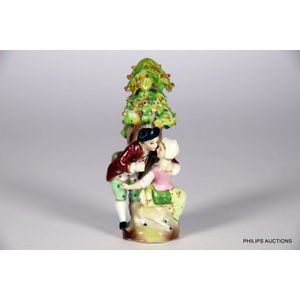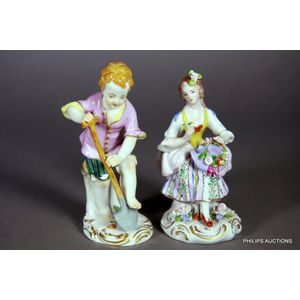Chelsea Porcelain 'Cupid on Donkey' Perfume Bottle, 1760
You must be a subscriber, and be logged in to view price and dealer details.
Subscribe Now to view actual auction price for this item
When you subscribe, you have the option of setting the currency in which to display prices to $Au, $US, $NZ or Stg.
- Gilding - Gilding is a method of ornamentation whereby a thin sheet of gold metal is applied to items made of wood, leather, ceramics, glass and silver for decorative purposes.
For furniture including mirrors, the sheet of gold is usually applied over a coating of gesso. Gesso is a mixture of plaster of Paris and gypsum mixed with water and then applied to the carved wooden frames of mirrors and picture frames as a base for applying the gold leaf. After numerous coats of gesso have been applied, allowed to dry and then sanded a coat of "bole", a usually red coloured mixture of clay and glue is brushed on and allowed to dry, after which the gold leaf is applied. Over time parts of the gilding will rub off so the base colour can be seen. In water gilding, this was generally a blue colour, while in oil gilding, the under layer was often yellow. In Victorian times, gilders frequently used red as a pigment beneath the gold leaf.
Metal was often gilded by a process known as fire gilding. Gold mixed with mercury was applied and heated, causing the mercury to evaporate, the long-term effect of which was to kill or disable the craftsman or woman from mercury poisoning. The pursuit of beauty has claimed many victims, not the least of which were the artists who made those pieces so highly sought after today. - Cupid Motif - The Cupid motif, which features the Roman god of love and desire, Cupid, was a popular decorative element in classical ornamentation. Cupid was often depicted as a winged, naked baby with a bow and arrow, and was often used to symbolize love and desire.
In classical art and architecture, Cupid motifs were often used as decorative elements on furniture, such as on the legs of chairs and tables, as well as on architectural elements such as friezes and pediments. They were also used as decorative elements in frescoes, mosaics, and other forms of art.
During the Renaissance, Cupid motifs were often incorporated into the decoration of palaces, churches and other grand buildings, as they were seen as symbols of love and fertility. Cupid motifs were also commonly used in the decorative arts of the Baroque period, often appearing in the form of putti, which are small winged cherub figures.
In addition to their decorative use, Cupid motifs were also believed to hold symbolic meaning, as they were thought to evoke feelings of love, desire, and fertility. - Circa - A Latin term meaning 'about', often used in the antique trade to give an approximate date for the piece, usually considered to be five years on either side of the circa year. Thus, circa 1900 means the piece was made about 1900, probably between 1895 and 1905. The expression is sometimes abbreviated to c.1900.
This item has been included into following indexes:
- Chelsea porcelain (England)
Visually similar items

A Sitzendorf porcelain figural perfume bottle, 19th century, after Meissen depicting a flirtatious shepherd and a reluctant shepherdess beside a tree with a sheep and a tree top stopper in polychrome enamels, blue crossed marks underside, height 10 cm

An Art Deco 'Crown Top' figural porcelain perfume bottle, circa 1920, German, a jauntily posed Columbine figure in a white dress with pink roses to the skirt, a green bodice, ruffled collar and mauve buttoned cap, and holding a bouquet of roses on her shou

Two porcelain polychrome figures: a Meissen Gardener and a Sitzendorf lady, 20th century, a gardener boy with a shovel, and a lady in eighteenth century country dress with a posy and a hat; both upon rococo bases; underglaze crossed swords and impressed nu

A pair of Staffordshire figures, 'Elijah', and 'The Widow', early 19th century, Pearlware figures modelled in the round before bocages raised on grassy bases and square stands, Elijah feeding the ravens, and the despondent widow in a green dress and cape c
